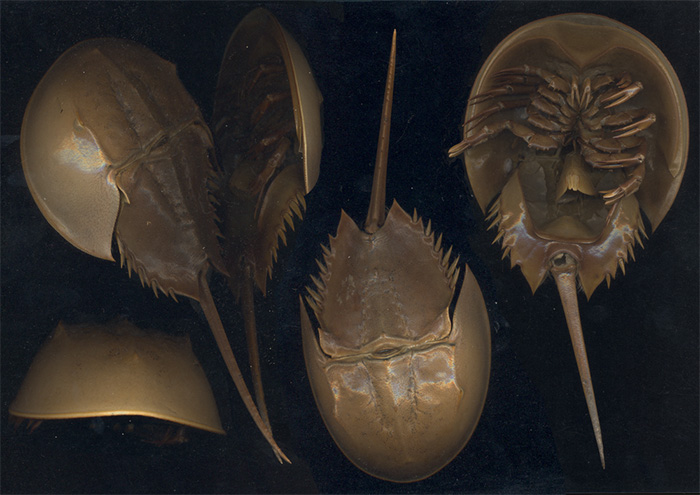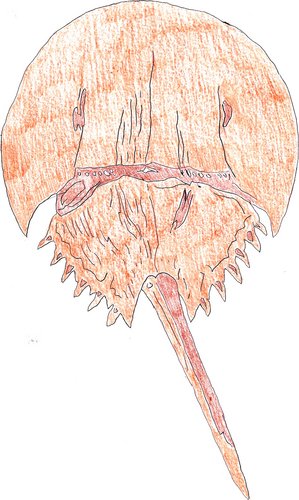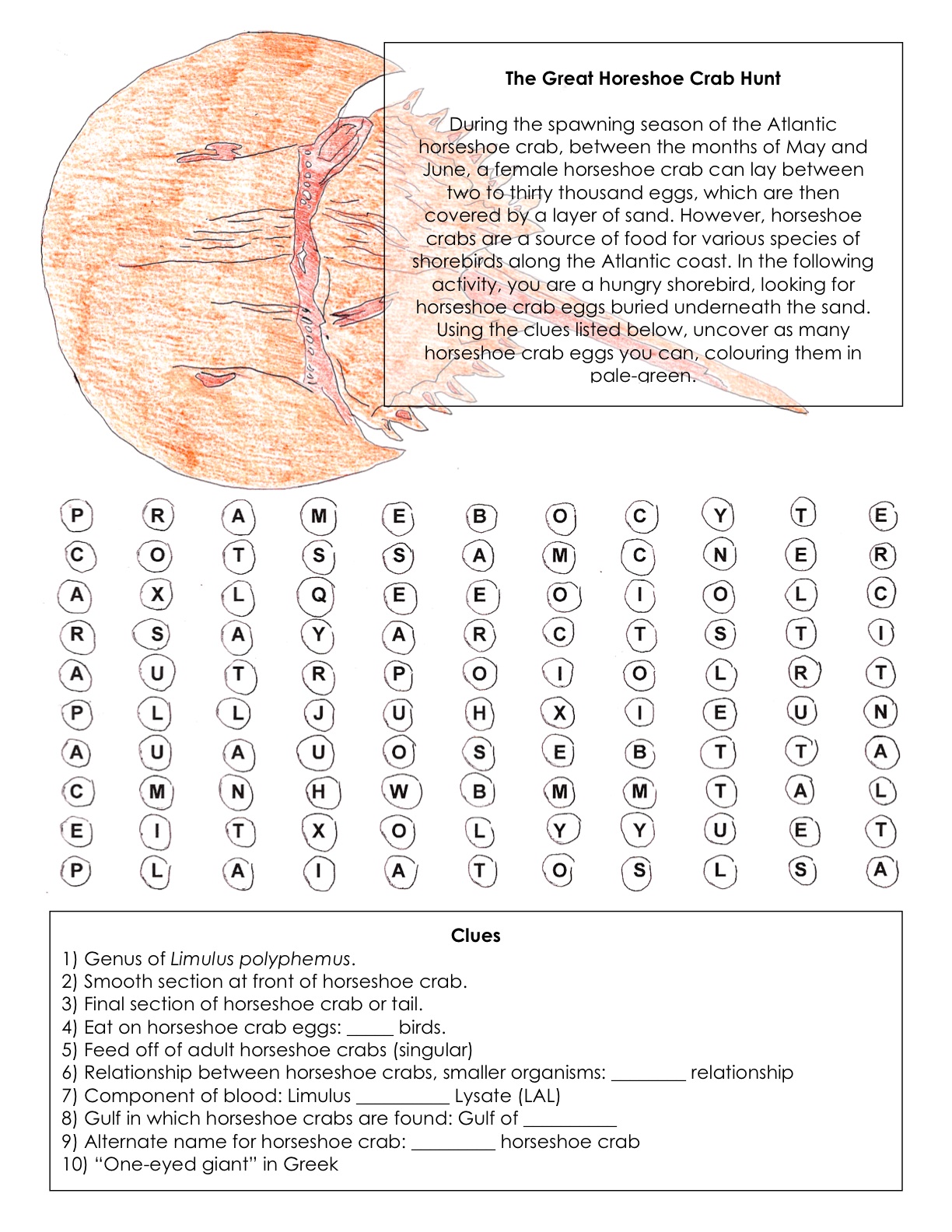

Various views of the Limulus polyphemus. © 2006 Chosovi
Classification
- Kingdom: Animalia
- Phylum: Arthropoda (joint-legged animals)
- Class: Merostomata (mouth surrounded by legs)
- Order: Xiphosurida (sword-tailed animals)
- Family: Limulidae
- Genus: Limulus (from Latin: somewhat odd, oblique)
- Species: Limulus polyphemus (from Greek: one-eyed giant)
Scientific and Common Name
The species Limulus polyphemus is commonly known as the Atlantic horseshoe crab or simply the horseshoe crab. The three other species in the family Limulidae (Tachypleus tridentatus, Tachypleus gigas and Carcinoscorpius rotundicauda) are also called horseshoe crabs and are quite similar in form and behaviour. Other common names for the horseshoe crab include the horsefoot, king crab and sauce-pan.
Despite its name and crab-like appearance, the horseshoe crab is more closely related to spiders, ticks and scorpions than to crabs. Scientists believe that the species descended from eurypterids (sea scorpions), evolving during the Palaeozoic Era. The four modern-day species of horseshoe crabs are the only living members of the class Merostomata (animals with a mouth surrounded by legs) and are often referred to as living fossils as they have changed little over the course of the past four hundred and forty five million years.
Physical Description
The outer shell of horseshoe crabs is composed of three distinct sections. The carapace is the smooth section at the front of the organism, which contains five pairs of eyes, one pair of small pincers, five pairs of leg-like appendages, the mouth, the brain and the heart. The abdomen of the horseshoe crab houses the organism’s five pairs of book gills and the genital operculum or reproductive organs. The final section, the telson or tail, is used to steer the horseshoe crab in the water and to flip itself over if ever stuck on its back. The horseshoe crab can grow up to sixty centimetres in length (including the tail), with the female being approximately twenty-five to thirty percent larger than the male.
Habitat
The Atlantic horseshoe crab is found primarily along the eastern North American coast from Nova Scotia to the Yucatán peninsula and in the Gulf of Mexico although some stray individuals have been found in Europe. The specific habitat requirements for adult horseshoe crabs are vague and somewhat unknown. Fully developed adult horseshoe crabs spend the spawning season in bay areas near the sandy spawning beaches of bays and coves. In the fall, adults may remain in bay areas or migrate to the Atlantic Ocean, where they spend the winter on the continental shelf, typically at depths of under thirty metres.
Reproduction and Life Cycle
Horseshoe crab spawning season generally occurs between the months of May and June, with peak spawning occurring at high tide during the full and new moons. Male horseshoe crabs grasp females during copulation with a specially developed appendage on their front claws. The female horseshoe crab then lays two to thirty thousand eggs in nests along the beach, which are then fertilized by the male’s sperm and later covered in sand.
At the full moon, larvae of about one centimetre in length hatch and must crawl to the surface of the beach in order to be washed away by the tide. Horseshoe crab larvae swim for about five to seven days, before settling and beginning the first moult. As horseshoe crabs grow, they move to deeper waters and continue to moult. At between nine to twelve years of age, the horseshoe crab reaches sexual maturity and may subsequently live for another ten to fourteen years.
Ecological Niche
The horseshoe crab plays an important ecological role in its food web. Several species of shorebirds depend on horseshoe crab eggs, exposed on the surface by waves and storms, as a source of food. Horseshoe crab eggs and larvae are also eaten by several species of fish including the American eel, killifish, silver perch, weakfish, kingfish, silversides, summer flounder and winter flounder. In addition, sea turtles are known to feed on adult horseshoe crabs.
As a horseshoe crab ages and begins to shed less frequently, a number of smaller organisms begin to attach themselves on the shell and underside of the horseshoe crab, living off the organism in a symbiotic relationship. On the shell of the horseshoe crab, barnacles, sponges, diatoms, fungi and bacteria can all be found, and although the majority of these organisms are harmless, certain types of fungi and bacteria can degrade the shell of the horseshoe crab over time, exposing the organism to other potentially lethal microbes. On the underside of the horseshoe crab, several species of flatworm scavenge for scraps of food that the organism may have missed.
Conservation Status
Although the horseshoe crab is not presently considered to be endangered, the horseshoe crab population has been declining in some areas since the 1970s and several factors threaten the species’ current numbers. In recent times, horseshoe crabs have been used as bait in fisheries, primarily the American eel and conch fisheries. In the biomedical industry, adult horseshoe crabs are valued for a component of their blood called Limulus Amebocyte Lysate (LAL), which can detect bacterial endotoxins in drugs and intravenous devices. To manufacture LAL, horseshoe crabs are caught, bled and then released alive but approximately ten to fifteen percent do not survive the procedure. Other factors, which place horseshoe crabs at risk, include shoreline development, habitat loss and pollution.
Activity: The Great Horseshoe Crab Hunt
The Great Horseshoe Crab Hunt is a word search activity intended to help students reinforce their knowledge of the horseshoe crab. In order to complete this activity, either print this page or download the original PDF file by clicking the link below. The answers to all of the clues can be found on this page.

Information on the Internet
- Ecological Research and Development Group. The Horseshoe Crab. 2006. Accessed 20 September 2008
- The Central Pets Educational Foundation. Horseshoe Crab Main Page. Accessed 20 September 2008
- University of Delaware Sea Grant College Program. Horseshoe Crab History, Biology, Research and Conservation. Accessed 20 September 2008
- Horseshoe Crab Accessed 20 September 2008






 Go to quick links
Go to quick search
Go to navigation for this section of the ToL site
Go to detailed links for the ToL site
Go to quick links
Go to quick search
Go to navigation for this section of the ToL site
Go to detailed links for the ToL site